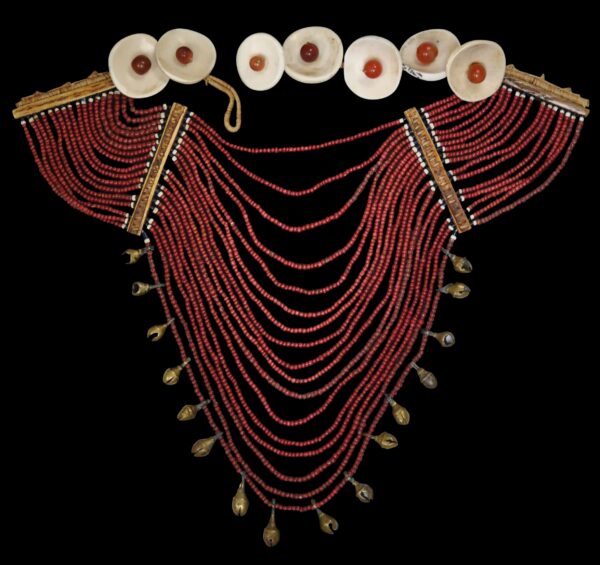This large, multi-strand necklace of red ‘white-heart’ and other trade beads as well as small cast brass bells is from the Naga people, probably the Konyak Naga, of North-West India and Western Burma.
Attractive, rectangular bone spacers have been used to give the necklace structure. The necklace retains its original threading and ends with seven splendid chank shell disks each set with a single carnelian bead. The necklace has a button and loop closure with one of the chank shells serving as a ‘button’.
Related necklaces are illustrated in Jacobs (1990, pp. 311-312), and a similar example is illustrated in Giehmann (2001, p. 39).
The Naga comprise a series of related tribal groups concentrated in the border areas of north-eastern India and eastern Burma. They were attracted to rare goods that could be bartered from outside their region. Beaded necklaces were very popular as a show of finery but also as a portable means of displaying and carrying wealth. The components that went into making necklaces were regarded as currency items themselves. Beads and necklaces were accumulated as heirlooms and were passed as dowries and down through generations.
The necklaces is in fine condition, has obvious age, and is stable and wearable.
References
Barbier, J.P., Art of Nagaland: The Barbier-Muller Collection Geneva, Los Angeles County Museum of Art, 1984.
Borel, F., The Splendour of Ethnic Jewelry: From the Colette and Jean-Pierre Ghysels Collection, Thames & Hudson, 1994.
Giehmann, M., Naga Treasures: Tribal Adornment from the Nagas – India and Myanmar, 2001.
Jacobs, J., The Nagas: Hill Peoples of Northeast India, Thames & Hudson, 1990.
Panini, A., Middle Eastern and Venetian Glass Beads: Eighth to Twentieth Centuries, Skira, 2007.
Saul, J.D., The Naga of Burma: Their Festivals, Customs and Way of Life, Orchid Press, 2005.
Shilu, A., Naga Tribal Adornment: Signatures of Status and Self, The Bead Museum, Washington, 2003.






